A perm, short for permanent wave, is a chemical treatment that alters the structure of the hair to create curls or waves that last for several months. While perms can transform straight or limp hair into bouncy curls, they also come with risks of damage and hair health concerns. In this comprehensive guide, we’ll explore the potential damage caused by perms, including the factors that contribute to damage, how to minimize risks, and tips for maintaining healthy hair post-perm.
Introduction to Perms
Perms have been a popular hair treatment for decades, offering individuals the opportunity to achieve curly or wavy hair without daily styling efforts. During a perm treatment, chemicals are used to break and reform the bonds in the hair, reshaping it into curls or waves that remain until the hair grows out or is cut. While perms can be a convenient way to change your hairstyle, they can also cause damage to the hair structure and overall hair health.
Understanding the Potential Damage
While some individuals may experience minimal damage from perms, others may face more severe consequences. Here are some ways in which perms can damage the hair:
1. Chemical Damage
The chemicals used in perm solutions, such as ammonium thioglycolate, sodium hydroxide, or guanidine hydroxide, can be harsh on the hair and scalp. These chemicals break down the protein bonds in the hair shaft to facilitate the restructuring process, which can weaken the hair and make it more susceptible to damage.
2. Overprocessing
Overprocessing occurs when the hair is exposed to perm solution for too long or is subjected to multiple perm treatments in a short period. Overprocessing can lead to hair breakage, dryness, and brittleness, as well as scalp irritation and sensitivity.
3. Heat Damage
Perm treatments often involve the use of heat, either from a hair dryer or a heat styling tool, to activate the chemicals and set the curls. Excessive heat can damage the hair cuticle, leading to dryness, frizz, and breakage.
4. Mechanical Damage
After a perm treatment, the hair becomes more fragile and prone to breakage, especially when wet. Vigorous brushing, combing, or styling can cause mechanical damage to the hair shaft, leading to split ends and breakage.
5. Incompatibility with Previous Treatments
Perms may not be suitable for individuals who have previously chemically treated or damaged hair. Mixing perm chemicals with other hair treatments, such as bleach or hair dye, can result in unpredictable outcomes and increased risk of damage.
Minimizing Risks and Maintaining Hair Health
While perms can be damaging to the hair, there are steps you can take to minimize risks and maintain hair health:
1. Consultation with a Professional
Before getting a perm, schedule a consultation with a professional hairstylist who specializes in perm treatments. They can assess your hair type, texture, and condition and recommend the most suitable perm technique and products for your needs.
2. Strand Test
Ask your hairstylist to perform a strand test before the perm treatment to assess the compatibility of your hair with the perm solution. A strand test involves applying a small amount of perm solution to a strand of hair to evaluate how it reacts and determine the optimal processing time.
3. Use Quality Products
Choose a reputable salon or hairstylist who uses high-quality perm products and follows safe and hygienic procedures. Cheap or low-quality perm solutions may contain harsh chemicals that can cause more damage to the hair.
4. Follow Aftercare Instructions
After getting a perm, follow your hairstylist’s aftercare instructions carefully to minimize damage and maintain hair health. This may include avoiding heat styling, using gentle shampoos and conditioners formulated for chemically treated hair, and avoiding tight hairstyles that can stress the hair shaft.
5. Regular Maintenance
Schedule regular trims and touch-up appointments to maintain the shape and condition of your perm. Trimming split ends and refreshing the curl pattern can help prevent further damage and keep your hair looking healthy and vibrant.
Conclusion
In conclusion, while perms can transform straight or limp hair into bouncy curls or waves, they also come with risks of damage and hair health concerns. The chemicals used in perm treatments can be harsh on the hair and scalp, leading to dryness, breakage, and scalp irritation. However, by taking precautions, consulting with a professional hairstylist, and following proper aftercare, you can minimize the risks associated with perms and maintain healthy hair post-treatment. Ultimately, the decision to get a perm should be made carefully, considering the potential risks and benefits for your individual hair type and condition.

